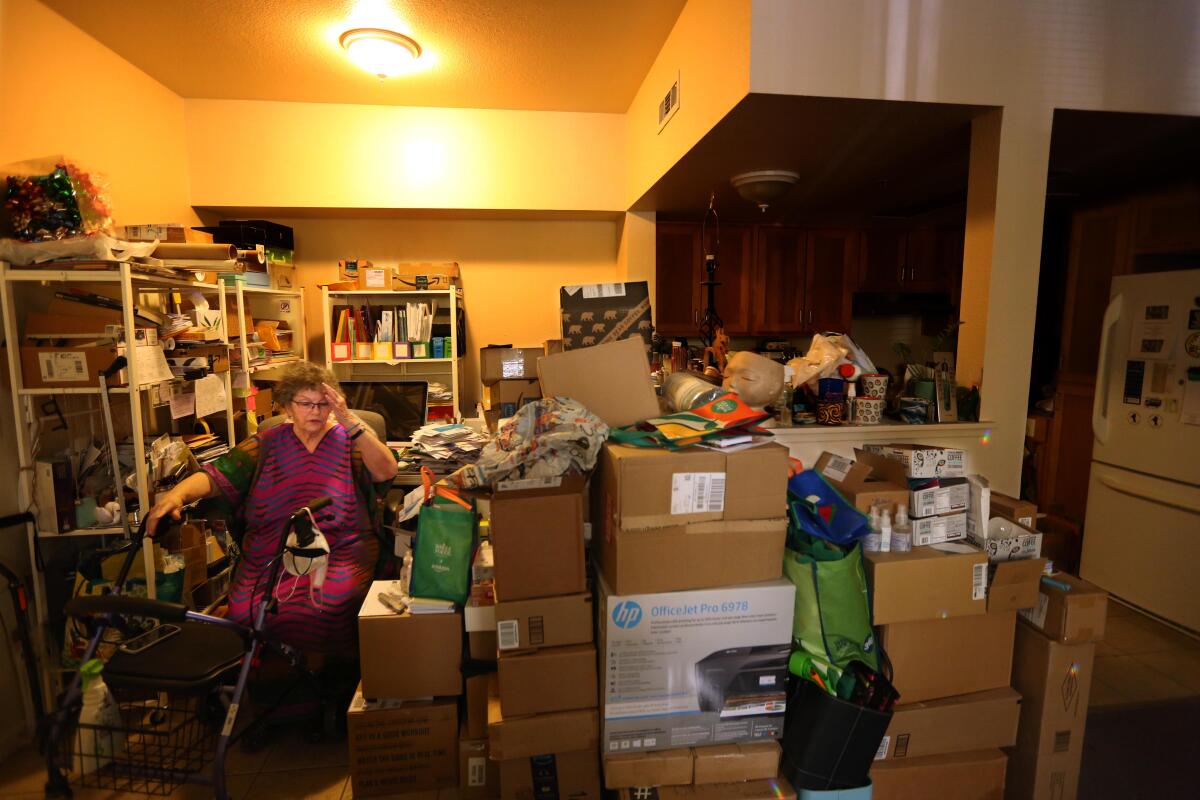California got $1.3 billion in wildfire relief. Victims have received nothing, prompting outrage

- Share via
After her home in Santa Rosa, Calif., burned down in the Tubbs fire three years ago, Linda Adrain moved into a tiny apartment. She didn’t expect to stay long.
Adrain soon learned about plans for a complex for low-income senior citizens on the site of the fire-ravaged mobile home park where she had lived for a quarter-century. She quickly signed up for a two-bedroom apartment.
But before breaking ground, developers were relying on funding from a federal disaster relief package approved by Congress a few months after the fire. They’re still waiting for the money. And so Adrain is still waiting for her new home.
“It’s supposed to be a temporary place, and I’ve been here for three years,” said Adrain, 80. “There’s nowhere for me to go.”
California has received more than $1.3 billion in federal aid to rebuild after the 2017 wine country wildfires, the 2018 Camp fire in Butte County and other disasters from those years. But disaster-affected homeowners and renters have yet to receive a single penny. The cause: years-long federal and state bureaucratic delays.
As a result, renters like Adrain are going without permanent housing while homeowners are unable to cobble together enough money to rebuild their homes. In the Butte County town of Paradise, which was heavily damaged in the Camp fire, disaster victims are still living in cars and recreational vehicles on their properties as they await further financial assistance.
“This was a delay we wished we wouldn’t have had,” said Gustavo Velasquez, director of the California Department of Housing and Community Development, which is responsible for giving out the money. “Families deserve to have this money out to rebuild their lives.”
More than 4,500 homes were wiped out and 22 people died in the Tubbs fire, which began in Napa County and spread through Santa Rosa in 2017. A year later, the Camp fire killed 85 people and destroyed nearly 14,000 homes, with much of the damage centered on Paradise.

In the wake of the disasters, the Federal Emergency Management Agency began providing temporary housing and other short-term assistance. Congress began approving further aid for California in February 2018 to permanently rebuild and prevent future disasters. About $300 million of that money is for 2017 relief; the remaining $1 billion is for the 2018 wildfires.
More than $300 million of the total is earmarked to finance new housing for low-income renters. An additional $250 million is dedicated to rebuild homeowners’ single-family homes. A third pot of money, more than $400 million, is set aside to repair roads, water systems and other infrastructure and make other public improvements aimed at lessening the effects of future fires.
To get access to the funding, California housing officials have needed to develop spending plans approved by the federal Department of Housing and Urban Development. But it took nearly two years after the disasters for HUD to sign off on any of the state’s proposals to respond to the 2017 wildfires. Last week, more than two years after the 2018 wildfires, federal officials finally authorized the state’s plans for that year’s relief efforts.
State housing officials expect Congress to OK additional funding for this year’s wildfires as well, which would again trigger the HUD approval process for the new money.
President Trump and California leaders have fought over wildfire prevention, immigration, climate change and numerous other issues, and the president has at times threatened to withhold disaster funding from the state. But there’s no evidence these disputes have held up this money.
Indeed, massive delays have beset disaster relief measures across the country, including dollars earmarked for hurricane-ravaged communities in Texas, Florida and Georgia in 2017. Additionally, Congress has approved more than $20 billion for Puerto Rico to recover from that year’s Hurricane Maria, yet the vast majority remained unspent as of this summer, according to a report from an internal congressional research agency.
The spending problems have attracted condemnation from Democrats and Republicans in Congress, with Sen. John Cornyn (R-Texas), typically an ally of the president, among those accusing the administration of having intentionally stalled the money nationwide. HUD officials have denied that they prevented the dollars from coming out. Instead, they’ve lamented the complicated requirements surrounding the disaster relief program, which include writing new regulations every time the money is authorized.
Legislation to simplify how HUD handles disaster relief has not advanced despite bipartisan support.
“Our federal government’s disaster recovery system is broken,” said Sarah Saadian, vice president of public policy at the National Low Income Housing Coalition, a Washington-based advocacy group that has tracked the issue. “These problems we run into every single time.”
Nevertheless, not every state is facing the same issues as California.
Hurricane Harvey and resulting floods in 2017 badly damaged at least 197,000 homes in Texas — an even more widespread catastrophe than the California wildfires. Though the pace of federal approval affected Texas’ recovery efforts, state officials have already spent nearly $1 billion of its almost $10-billion allocation as of November, according to state statistics.
In California, around the time the 2017 fires hit, HUD investigators were examining the state housing department’s handling of other federal grants. They found a “systemic failure” in how the department monitored the money it handed out. HUD officials have said the state’s internal oversight issues, which housing officials here did not dispute, contributed to the delays in approving disaster relief plans.
More recently, it took Gov. Gavin Newsom nearly seven months after the previous state housing director resigned to appoint Velasquez to the position in the spring. Velasquez said the gap at the top of the department, which occurred after HUD had approved much of the state’s 2017 disaster spending, further slowed the pace.
“There was a void in leadership,” he said.
In the meantime, those in need are left waiting, sometimes frustrated by deadlines set by other government agencies.
The city of Santa Rosa has a dozen affordable housing complexes in varying stages of development that are in need of funding and could probably take advantage of the relief dollars, said David Gouin, the city’s director of housing and community services. If they’re all built, the projects would add more than 950 new apartments for low-income families.
In Paradise, the town’s largest low-income housing complex burned down during the Camp fire. Its developer, Community Housing Improvement Program, is in the process of rebuilding and would be eligible for disaster relief funding. But the project is getting squeezed by Internal Revenue Service regulations that call for affordable housing projects to be reoccupied within two years after they’re destroyed. Financing for the project remains precarious, said Seana O’Shaughnessy, the developer’s president and chief executive.
The town has allowed homeowners to legally park recreational vehicles and have other temporary housing on their properties through June, already prolonging its original time limit by six months because so few people have been able to gather sufficient money to rebuild.
“There’s no way around wanting to have the assistance sooner so people are not living in tents, living in cars, living in RVs and doing so for years,” said Casey Hatcher, deputy chief administrative officer for Butte County. “The longer that happens, the harder it is to get people out of those situations.”
State housing officials expect that money for 2017 wildfire relief will start flowing in early 2021. And they believe they’re prepared to spend more quickly in the future. In late October, the housing agency tweeted that it’s “urgently hiring” for 18 new jobs to manage disaster relief programs. Velasquez said he hopes to have the workers beginning as the federal government is signing off on the state’s plans for the 2018 disasters.
“Finally, we’re getting to a point where we can say confidently this money is coming out,” Velasquez said.
For Adrain, though, the wait will continue. Even when the senior housing development on the old mobile home park receives its final approval, it could take two more years before it’s finished.
If all remains on schedule, it will be more than five years from when her home burned down until she’ll be able to move into her new apartment. She’s already thinking about the day.
“I’m going to feel like I’m home,” Adrain said. “I’m probably never going to move out of there.”
More to Read
Sign up for Essential California
The most important California stories and recommendations in your inbox every morning.
You may occasionally receive promotional content from the Los Angeles Times.







